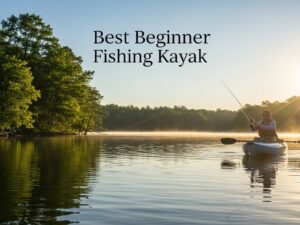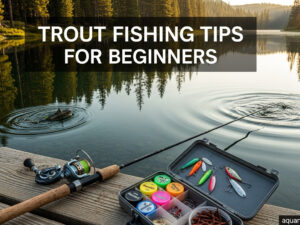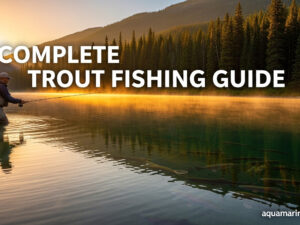Lake Michigan fishing offers some of North America's most rewarding angling experiences, with world-class salmon, steelhead, and lake trout populations thriving in 22,300 square miles of pristine Great Lakes waters. Whether you're targeting trophy chinook salmon from Chicago's harbors or casting for steelhead along Wisconsin's shores, Lake Michigan delivers consistent action throughout the fishing season from April through October.
This massive freshwater sea holds record-setting fish and supports a multi-million dollar charter industry across Illinois, Indiana, Michigan, and Wisconsin. From understanding seasonal migration patterns to mastering trolling techniques for different species, success on Lake Michigan requires knowledge of the lake's unique characteristics and fish behavior.
In this comprehensive guide, you'll discover prime fishing locations, seasonal patterns, essential tackle recommendations, and proven techniques that consistently produce results on America's fifth-largest lake.
Essential Lake Michigan Fish Species and Seasonal Patterns
Understanding the diverse fish found in Lake Michigan forms the foundation for successful angling. The lake's cold, deep waters support both native species and introduced salmon and trout that have created world-class fishing opportunities.
Trophy Salmon Species
Chinook (King) Salmon represent the lake's premier gamefish, with mature specimens reaching 20-30 pounds regularly. These powerful fish migrate from deep water to nearshore areas during spring and fall, making them accessible to both charter boats and shore anglers.
Peak chinook season runs from late July through September, when fish stage in 60-120 feet of water before making their spawning runs. The best types of fishing techniques include downrigger trolling with spoons and plugs.
Coho Salmon provide explosive surface action, especially during their spring and early summer runs. These acrobatic fighters average 5-12 pounds and often feed aggressively in shallower water than chinooks.
Coho respond well to trolling presentations in the upper 40 feet of the water column, particularly during overcast conditions or low-light periods.
Premium Trout Varieties
Steelhead (Rainbow Trout) offer year-round fishing opportunities, with spring and fall providing the most consistent action. These chrome-bright fish average 8-15 pounds and fight with incredible stamina.
Spring steelhead fishing peaks from April through June, when fish concentrate near tributary mouths and thermal bars. These conditions create some of the most exciting fishing on Lake Michigan Chicago experiences.
Brown Trout grow to impressive sizes in Lake Michigan's nutrient-rich waters, with fish over 15 pounds caught regularly. Browns prefer slightly deeper water than steelhead and often suspend along temperature breaks.
Lake Trout thrive in the lake's deepest, coldest waters year-round. These native fish can exceed 20 pounds and provide steady action for anglers willing to fish depths of 80-200 feet.
Prime Lake Michigan Fishing Locations and Access Points
Lake Michigan fishing map analysis reveals numerous productive areas, each offering unique advantages for different species and seasons. Strategic location selection dramatically impacts your success rates.
Illinois Fishing Hotspots
Chicago Harbor Area provides convenient access from the nation's third-largest city, with Montrose, Belmont, and Burnham harbors serving as primary departure points. The Chicago lakefront offers excellent early morning and evening fishing during summer months.
Fishing on Lake Michigan Chicago requires understanding urban fishing pressures and timing. Dawn and dusk produce the best results, particularly for salmon and steelhead staging near harbor entrances.
Waukegan Harbor sits approximately one hour north of Chicago and consistently ranks among the lake's most productive fishing locations. The deep water access and proximity to major fish concentrations make this a charter fishing hub.
Professional charter services from Waukegan regularly report limit catches during peak seasons. The harbor's strategic position provides quick access to both nearshore and offshore fishing grounds.
Michigan's Premier Fishing Areas
Grand Haven and Holland offer excellent access to Michigan's productive eastern shoreline. These ports provide launching points for targeting salmon during their fall runs and steelhead during spring migrations.
The Michigan shoreline features numerous tributary mouths that concentrate fish during spawning periods. Understanding these trout fishing Tennessee-style river fishing principles applies to Great Lakes tributaries as well.
Traverse City Area provides access to Grand Traverse Bay's diverse fishing opportunities. The bay's varied depths and structure create ideal habitat for multiple species throughout the season.
Wisconsin Fishing Destinations
Milwaukee and Port Washington serve Wisconsin's charter fishing industry with professional operations targeting salmon and trout year-round. These ports offer convenient amenities and launching facilities.
The Wisconsin shoreline benefits from favorable currents and thermal patterns that concentrate baitfish and attract predator species throughout the fishing season.
Lake Michigan Fishing Chart: Seasonal Success Calendar
| Month | Primary Species | Best Techniques | Water Depth | Success Rating |
|---|---|---|---|---|
| April | Steelhead, Coho | Trolling, Casting | 20-60 feet | Excellent |
| May | Brown Trout, Lake Trout | Downrigging | 40-100 feet | Very Good |
| June | Coho, Chinook | Surface trolling | 30-80 feet | Excellent |
| July | Chinook, Lake Trout | Deep trolling | 60-150 feet | Outstanding |
| August | All salmon species | Mixed techniques | 40-120 feet | Outstanding |
| September | Chinook, Coho | Near-shore trolling | 30-80 feet | Excellent |
| October | Steelhead, Browns | Casting, trolling | 20-60 feet | Very Good |
This Lake Michigan fish chart provides essential timing information for planning successful fishing trips throughout the season.
Advanced Techniques and Tackle Recommendations
Mastering Lake Michigan requires understanding specific techniques adapted to the lake's unique conditions and fish behavior patterns.
Trolling Strategies
Downrigger Trolling represents the most effective method for consistently locating and catching fish in Lake Michigan's vast waters. Quality downriggers allow precise depth control and presentation of lures at specific temperature zones.
Successful downrigger setups include multiple lines at varying depths, typically ranging from 20 feet to 100+ feet depending on conditions. Using different lure types and colors increases your chances of triggering strikes.
Lead Core Trolling provides an alternative approach that allows lures to reach moderate depths without downriggers. This technique works particularly well for covering large areas when searching for actively feeding fish.
Shore Fishing Techniques
Pier and Harbor Fishing offers accessible opportunities for anglers without boats. Many harbors along Lake Michigan provide excellent fishing during salmon and trout runs.
Understanding the best fishing piers in Miami principles of structure fishing applies to Great Lakes pier fishing as well, where fish relate to harbor walls and breakwaters.
Beach Casting becomes productive during specific conditions, particularly when baitfish schools move close to shore. Early morning and evening hours typically provide the best opportunities.
Essential Tackle Selection
Rods and Reels must withstand the demands of trolling heavy lures and fighting large fish. Quality trolling rods in 8-10 foot lengths paired with line counter reels provide the foundation for success.
Consider the various best types of fishing boats available for Lake Michigan fishing, from small aluminum boats to large charter vessels.
Line and Leaders require careful selection based on fishing techniques and target species. Many anglers prefer fluorocarbon leaders for their invisibility and abrasion resistance.
Lure Selection varies dramatically based on season, species, and fishing conditions. Successful anglers maintain collections of spoons, plugs, flies, and soft plastics in multiple colors and sizes.
Understanding Lake Michigan Fishing Report Today Conditions
Staying current with fishing conditions dramatically improves your success rates on Lake Michigan's dynamic waters.
Weather Pattern Impact
Wind Direction and Speed profoundly influence fishing success. Offshore winds typically create clearer water conditions, while onshore winds can muddy nearshore areas but concentrate baitfish.
Temperature Changes trigger fish movement patterns throughout the season. Understanding thermal bar formation and temperature breaks helps locate active fish concentrations.
Real-Time Fishing Intelligence
Professional Charter Reports provide valuable insights into current fishing patterns, productive depths, and effective lure presentations. Many charter operators share daily reports through social media and fishing forums.
Marina Intelligence gathered from dock conversations and tackle shop reports often reveals recent fishing success and emerging patterns.
Baitfish Monitoring
Alewife Populations form the foundation of Lake Michigan's food chain. Understanding alewife distribution and behavior helps predict predator fish locations and feeding patterns.
Seasonal Movements of baitfish schools directly influence salmon and trout behavior. Successful anglers learn to "match the hatch" by using lures that imitate prevalent baitfish.
Charter Fishing vs. Do-It-Yourself Options
Choosing between charter fishing and independent fishing depends on experience level, equipment availability, and fishing goals.
Charter Fishing Advantages
Professional Expertise provides access to years of accumulated knowledge about Lake Michigan fishing patterns, productive locations, and proven techniques.
Equipment Provided eliminates the need for significant tackle investments, especially for occasional anglers or visitors to the area.
Safety and Navigation benefits include professional boat handling, safety equipment, and knowledge of local hazards and navigation challenges.
Popular charter operations from Chicago, Waukegan, and other major ports offer half-day and full-day fishing experiences throughout the season.
Independent Fishing Benefits
Cost Savings become significant for frequent anglers, especially when fishing with family or friends on a regular basis.
Flexibility allows anglers to fish on their own schedule, explore different areas, and develop personal fishing skills and knowledge.
Equipment Control enables anglers to use preferred tackle and customize their fishing approach based on personal preferences.
Consider your skill level and equipment when deciding between charter and independent fishing approaches.
Lake Michigan Fishing Calendar: Monthly Success Guide
Understanding seasonal patterns maximizes your fishing success throughout Lake Michigan's extended fishing season.
Spring Fishing (April-May)
April Opportunities center on steelhead runs and early coho salmon fishing. Water temperatures in the 40s create excellent conditions near harbor areas and tributary mouths.
Shore fishing becomes productive during this period, with pier fishing providing accessible opportunities for anglers without boats.
May Transitions bring warming water and increased fish activity. Brown trout and lake trout fishing picks up significantly, while coho salmon fishing reaches its spring peak.
Summer Peak Season (June-August)
June Excellence provides some of the year's best fishing as all species become active. Surface water temperatures climb into the 50s and 60s, creating ideal fishing conditions.
July and August represent the peak fishing season with trophy chinook salmon joining coho, steelhead, and trout in accessible depths.
Fall Fishing (September-October)
September Salmon Runs create some of the year's most exciting fishing as mature chinook salmon stage near harbors preparing for spawning runs.
October Transitions bring excellent steelhead and brown trout fishing as water temperatures cool and fish feed aggressively before winter.
Safety and Regulations for Lake Michigan Fishing
Lake Michigan's size and power demand respect and proper safety preparations from all anglers.
Essential Safety Equipment
Coast Guard Requirements mandate specific safety equipment based on boat size and capacity. All vessels must carry appropriate life jackets, signaling devices, and fire extinguishers.
Weather Monitoring capabilities become critical on Lake Michigan's rapidly changing conditions. Marine weather radios provide essential real-time weather information.
Communication Equipment including cell phones, marine radios, or satellite communicators ensure emergency contact capabilities.
Licensing and Regulations
Multi-State Considerations complicate Lake Michigan fishing since the lake borders four states with different regulations and licensing requirements.
Species-Specific Regulations include size limits, bag limits, and seasonal restrictions that vary by species and location.
Salmon Stamp Requirements apply in most states for anglers targeting salmon species. Check current regulations for specific requirements in your fishing area.
Advanced Tips from Professional Guides
Learning from Lake Michigan's professional charter captains accelerates your fishing success and knowledge development.
Depth and Temperature Strategies
Thermocline Fishing becomes critical during summer months when fish concentrate in specific temperature zones. Quality depth finders with temperature capability help locate these productive areas.
Structure Fishing around underwater humps, drop-offs, and reefs concentrates fish and increases catch rates significantly.
Lure Presentation Techniques
Speed Control dramatically affects lure action and fish response. Successful trolling speeds typically range from 1.8 to 3.5 mph depending on species and conditions.
Color Selection varies based on water clarity, light conditions, and fish preferences. Successful anglers carry diverse color selections and change presentations based on fish response.
Reading Water Conditions
Bird Activity often indicates baitfish concentrations and feeding fish. Gulls, terns, and cormorants provide valuable clues about underwater fish activity.
Surface Signs including jumping fish, swirls, and baitfish activity help locate feeding areas and active fish concentrations.
Common Mistakes to Avoid
Learning from common fishing mistakes saves time and increases your Lake Michigan fishing success.
Equipment Errors
Inadequate Rod Selection limits your ability to properly present lures and fight large fish. Quality trolling rods make a significant difference in fishing success.
Line Selection Mistakes include using line that's too light for conditions or too visible for clear-water situations.
Technique Problems
Poor Depth Control prevents lures from reaching fish holding at specific depths. Understanding and controlling lure presentation depth is critical for consistent success.
Trolling Speed Errors either too fast or too slow can dramatically reduce lure effectiveness and fish strikes.
Location Selection Issues
Ignoring Weather Conditions leads to fishing unproductive water or potentially dangerous situations. Always check weather forecasts before departing.
Following Crowds rather than understanding fish behavior often results in fishing pressured, unproductive areas.
Seasonal Equipment Storage and Maintenance
Properly maintaining your Lake Michigan fishing equipment ensures peak performance and extends equipment life.
Post-Season Equipment Care
Thorough Cleaning removes salt residue and prevents corrosion on reels, rod guides, and tackle boxes. Fresh water rinses after each trip help prevent long-term damage.
Reel Maintenance includes cleaning, oiling, and proper storage to ensure smooth operation throughout the fishing season.
Tackle Organization
Seasonal Tackle Rotation helps organize equipment based on fishing seasons and target species. Proper organization saves time and ensures you have appropriate tackle available.
Equipment Inventory conducted during off-season helps identify needed replacements and additions for the upcoming fishing season.
Planning Your Lake Michigan Fishing Adventure
Successful Lake Michigan fishing trips require advance planning and preparation for varying conditions and opportunities.
Trip Planning Essentials
Weather Window Selection maximizes your chances of favorable fishing conditions. Lake Michigan's weather can change rapidly, making flexible planning important.
Accommodation Planning near major fishing areas ensures convenient access to departure points and allows early morning departures.
Group Fishing Considerations
Charter Boat Selection varies significantly based on group size, experience level, and fishing goals. Research charter operators thoroughly before booking.
Equipment Sharing can reduce individual costs while ensuring everyone has access to appropriate fishing equipment.
Understanding these principles, combined with the various fishing techniques enjoyed by anglers, creates memorable fishing experiences on Lake Michigan.
Frequently Asked Questions
What is the best time of year for Lake Michigan fishing?
Late summer through early fall (July-September) provides the most consistent action across all species. Spring (April-May) offers excellent steelhead fishing, while summer brings the best salmon fishing opportunities.
Do I need a special license for Lake Michigan fishing?
Yes, you need a valid fishing license from the state where you're fishing, plus salmon stamps in most locations. Since Lake Michigan borders four states, check regulations for your specific fishing area.
What fish species can I expect to catch in Lake Michigan?
Primary species include chinook salmon, coho salmon, steelhead trout, brown trout, lake trout, and yellow perch. Seasonal availability varies, with summer providing access to the most diverse species mix.
How deep should I fish in Lake Michigan?
Fishing depths vary by season and species. Spring fishing often occurs in 20-60 feet, while summer fishing may require depths of 60-150 feet. Use downriggers or lead core lines to reach fish consistently.
Is shore fishing effective on Lake Michigan?
Shore fishing can be very productive, especially from piers and harbors during salmon and steelhead runs. Early morning and evening hours typically provide the best shore fishing opportunities.
Lake Michigan fishing offers unmatched opportunities for anglers seeking world-class freshwater fishing experiences. From trophy chinook salmon to acrobatic steelhead, this Great Lake provides consistent action throughout an extended fishing season.
Success requires understanding seasonal patterns, proper equipment selection, and proven techniques adapted to Lake Michigan's unique conditions. Whether you choose professional charter services or independent fishing adventures, this magnificent fishery rewards prepared anglers with memories that last a lifetime.
Start planning your Lake Michigan fishing adventure today by checking current fishing reports, weather conditions, and making appropriate preparations for safe, successful fishing experiences on America's inland sea.



